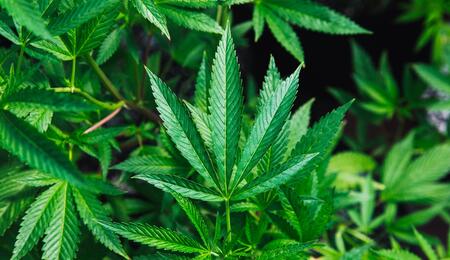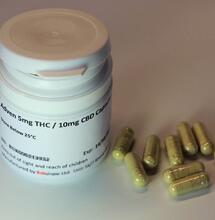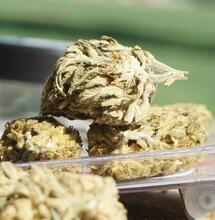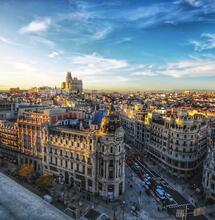Growing with LED

Growing cannabis under artificial light has long been more than just sodium-vapor and metal-halide lamps.
Over the last decade, LED technology has earned its rightful place above plants, and the future of this technology is more than promising. Growing with LED modules has its specifics, pros and cons. In the following article, you will get to know the most important features and also learn about the results of one particularly interesting research.
How it all began
When LED modules started appearing on the plant-growing market several years ago, I was curious how long it would take for them to reach the quality of traditional, high-intensity lamps. My first experience with LED was not too bad, on the contrary. The plants grew strong with dark green color and their flowers were strong and stiff, too.
That includes the lower ones, which does not always happen even under sodium-vapor lamps. You could see at first sight that the flowers were completely covered in resin. The taste, smell and effects of the first LED-grown harvest were all excellent, as several people that were able to try it have confirmed. The crop was not the richest, but considering the lower power consumption, it was still above average.
On the other hand, if I used a sodium-vapor lamp over the same growing area, I would get at least 50% more in the same amount of time. One of the reasons for that is the fact that I used a 300 W LED module instead of the original 600 W sodium-vapor lamp. With the knowledge from my first experience, I would have now rather used LED module rated for more than 400 W.
The plants growing under the LED light were shorter than I was used to, they had thicker stems and were generally more compact. The second harvest had the same qualities as the first one, but its quantity has decreased. The reason for that was a decrease in room temperature compared to the first growth cycle. This temperature difference was caused by coming winter.
From my experience with sodium-vapor lamps, I was used to dealing with temperatures that were too high instead of too low, and that is why the area was not artificially heated. As you can see, I have encountered several differences in cultivating under LED lights compared to sodium-vapor lamps from the very beginning. During that time, the reactions of people trying LED were mostly negative. The modules were expensive, and the outcomes did not reach the promised results or savings. Many resellers promised unrealistic decrease in power consumption but were unable to provide the necessary information for growing under LED lights. The situation has completely changed since then and even people that were totally against LED modules in the beginning are trying them now.
Climate conditions for LED
Whether you are switching to LED modules from sodium-vapor and metal-halide lamps or want to start growing with them from the ground up, it is important to account for a heating unit for the cultivation area, especially during winter or in colder regions. The optimal temperature for proper plant growth is 24-28 °C. For growing plants under LED, it is better to keep it between 26 and 29 °C.
It is also important to keep the humidity higher, ideally around 60 %. Even under LED lights, there is still the risk of mold in the last weeks of flowering, of course. That is why the humidity should be decreased to 40 % in the last two to four weeks before harvest. While the climate conditions change rapidly thanks to the variable running times of sodium-vapor lamps, LED lights do not affect them too much. That is a big advantage, especially for domestic growers in warmer regions, where the temperature does not drop below 20 °C and usually stays above 30 °C in summer.
Cultivation method
The intensity of the lighting and the composition of the light spectrum emitted by the light source significantly affect the morphology of plants, the formation of their resin, the amount of cannabinoids and other active substances. The light from sodium-vapor lamps is rich in green, yellow and red spectrums. The plants grow taller and have larger internodal gaps under this type of light. Most sodium-vapor lamps are weaker in the blue spectrum. The versions with added blue spectrum have a lower amount of red spectrum light.
In comparison, most LED modules for cultivation are stronger in the blue spectrum but not as strong in red and yellow spectrums. This results in a shorter plant height and smaller internodal gaps. High-end LED modules allow the user to adjust the emitted spectrum according to their needs, which can differ depending on the vegetative phase the plants are currently in. Another important factor is the fact that sodium-vapor lamps cannot be hung too low above the plants without cooled reflectors thanks to their high operational temperature.
LED sources can be hung right above the plants. Thanks to the power savings of LED modules, we usually replace stronger sodium-vapor lamps with less powerful LED modules, but these have a lower light intensity when comes to increasing distance between plants and them. Because of this lower intensity, the light does not penetrate in such amounts deeper into the growth. That is why it is better to grow shorter plants to reach optimal results, so that the distance between the top and bottom flowers is as short as possible. The aforementioned higher amount of blue spectrum helps that already, but it can also be achieved using SOG or ScrOG methods.
Irrigation and fertilization
When the temperature in the cultivation area is lower and the plants grow shorter, it results in slower water evaporation not only from the growth substrate, but also from the plants themselves. And that is exactly what happens during cultivation under LED. Even if the temperature in the cultivation area is the same (which it should because plants simply need heat), the water consumption would decrease because of the smaller volume of plants.
Larger plants consume more water and that leads to more water evaporating into the air. That is exactly the case with sodium-vapor lamps. The logical conclusion is then to decrease the number of plants and amount of irrigation when cultivating under LED modules. Many growers overwater their plants, which leads to a number of problems and a generally poor crop. It is one of the most common mistakes, regardless of the illumination technology used.
Many gardeners who switched from sodium-vapor lamps to LED lights achieved much worse results only because they kept the irrigation program the same. The highest risk is with active automatic irrigation system. With manual irrigation, you can notice the problem right away and I have never come across overwatering problem in good quality passive systems. There are discussions among growers whether the amount of fertilizers should be decreased when using LEDs. Some resellers recommend lowering the dosage by 30%.
Their reasoning is that the slower consumption of the nutrient solution together with the volumetrically smaller plants leads to faster water evaporation from the growing medium and results in higher nutrient concentration in the medium itself. I believe that this generally depends on the medium used, its amount and most importantly on the irrigation system. We already know quite precisely what the ideal climate and growth conditions are. I grow in a passive cultivation system under both LED and sodium-vapor lamps and I feed the plants from one tank. The nutrient solution has the same nutrient concentration and I have never encountered over-fertilization. If the nutrient solution stays in the growth medium for too long, the error is usually in the irrigation method, the amount of the growing medium or its type.
Lighting and cannabinoid content
In the beginning of this article, I have mentioned that I was surprised by the amount of resin after the first harvest under LED. I was not the only one to notice that. The light spectrum of LED modules encourages higher resin yield, probably thanks to the increased amount of blue spectrum light. It has been proven that adding UV-B radiation can make plants produce more resin and impact the production of cannabinoids. I have found a link to an interesting research paper on the website of one of the biggest manufacturers of garden lights. It is called The Effect of Light Spectrum on the Morphology and Cannabinoid Content of Cannabis sativa L. and its authors are Magagnini G, Grassi G and Kotiranta S.
This Italian-Finnish team of scientists tested three light sources used for the cultivation of cannabis – a traditional sodium-vapor lamp and two LED modules. Each light was tested in its own chamber, so that their light would not mix. The light fixtures were hung in such a way that the PPFD value reached 450 μmol/m2s at the top of the plants. Thanks to this, it was possible to perfectly compare the real influence light spectrum has on the observed indicators.
The results have confirmed that plants growing under a sodium-vapor lamp grew faster, had larger internodal gaps and produced a higher volume of green matter. They also yielded the highest amount of dried flowers by weight. On the other hand, plants grown under LED modules had a higher volume of cannabinoids and also differed in the volumes of THCa, CBDa, CBNa and CBGa.
When the researchers added up the total amount of cannabinoids, the yield from plants grown under sodium-vapor lamps and plants grown under LED modules was equal. The test was repeated twice and afterwards, the team came to a clear conclusion: by adjusting the light spectrum, it is possible to fundamentally affect the morphology of plants and the concentration of cannabinoids. The whole research paper is available on the internet for free.
The future of LED
The ways of changing the light spectrum of sodium-vapor lamps are quite limited compared to LED technology. Diodes can be combined in an infinite number of possibilities and the light can thus be changed even during growth. In the future, it will not matter how many dried flowers can be harvested from a plant, but how many specific cannabinoids can be extracted from it. This will play a huge role not only in the pharmaceutical industry, but also in the creation of products for recreational users, who are going to move away from dried flowers, especially if the wave of legalization continues. In such a situation, LED lighting will have a major advantage.



